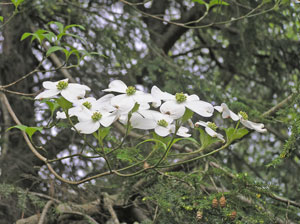Beware the march of the Bradford pears

The natural beauty of the Dogwood is under increasing competition from the Bradford pear. Photo by Ken Moore.
By Ken Moore
Flora Columnist
Approaching Carrboro along Jones Ferry Road is always a botanically joyful experience of viewing our seasonal wild flora from the spectacular flowering trees in the spring to the more subtle beauty of native grasses in the late summer and fall. Right now the roadsides are magical with the overlap of the flowering of the pink-colored redbuds (Cercis Canadensis) and the pure white of the dogwood tree (Cornus florida), the official state flower. Our North Carolina redbud and dogwood are just two of the numerous native plants that are ideal for urban and residential landscaping. Local nurseries and garden centers are well stocked right now with special cultivars of these two beauties. These cultivars, special forms of wild occurring plants, have been propagated by nurseries for sales to the admiring public, who always want to plant something special.
I, however, am a lazy gardener, preferring to let the redbuds and dogwoods plant themselves, with a little help from nature. My minimal gardening activity alllows these plants to remain in place where they volunteer. My reward is a month-long floral display free of any planting and watering responsibility for me. By reinquishiing a need to be rigidly in control of nature and a dictator of my garden design, my “gardening with Nature†practices allow me more time to enjoy the seasons. Each year the experience is different because I let Nature guide where I plant, where I weed and where I may seldom mow a pathway. Most homeowner associations will not approve of such relaxing and environmental gardening.
So what do dogwoods and redbuds have to do with Bradford pears—that short flowering, ever so popular, white flowering tree that has been unimaginatively over-planted in parking lots and along residential streets throughout our region? Well now, in contrast to the lovely Jones Ferry roadside (and other local roadsides), over on the other side of Chapel Hill near Research Triangle Park, in areas adjacent to Bradford pear-filled parking lots, there is frightening evidence of the threat posed by this exotic (i.e., not native to our region) plant so innocently introduced into our region. Open fields that in former times, left to nature, would have returned to forests of native pines, red cedars, sweetgums, maples and oaks, and, yes, even our favorite redbuds and dogwoods, are now in many places 50 percent to 75 percent young forest of Bradford pears, crowding and shading out the native species that should be there. Last week, back on our side of town, I noticed Bradford pears flowering along the wooded roadside just west of the Carrboro Post Office, innocent-looking enough, nestled in there with several dogwoods, with very few people noticing and being aware that in time those beautiful dogwoods and redbuds, that flower many days longer than the pear, will be crowded out by the more aggressive introduced exotic plant.
So, if you value our redbuds and dogwoods and other such desirable native species, please don’t plant Bradford pears, and if you really want to accomplish a good deed—get rid of the Bradford pears you already have—our future roadsides and fields and forests will appreciate your action.
Email Ken Moore at flora@carrborocitizen.com.


Comments are closed.